Citroen DS4 RHD 2013.5 1.G Owner's Manual
Manufacturer: CITROEN, Model Year: 2013.5, Model line: DS4 RHD, Model: Citroen DS4 RHD 2013.5 1.GPages: 400, PDF Size: 31.86 MB
Page 271 of 400
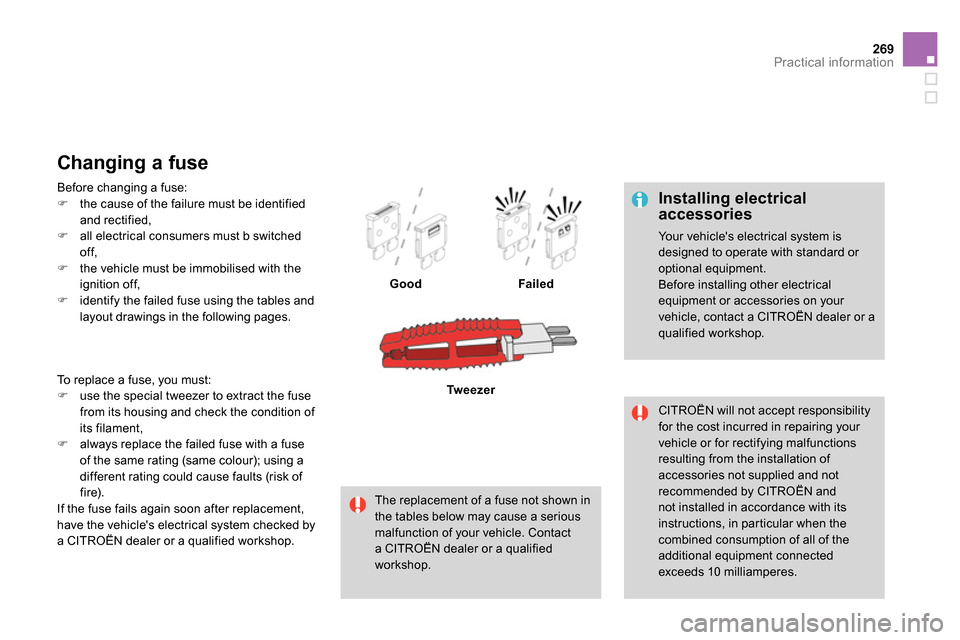
269Practical information
Installing electrical
accessories
Your vehicle's electrical system is
designed to operate with standard or
optional equipment.
Before installing other electrical
equipment or accessories on your
vehicle, contact a CITROËN dealer or a
qualified workshop.
CITROËN will not accept responsibility
for the cost incurred in repairing your
vehicle or for rectifying malfunctions
resulting from the installation of
accessories not supplied and not
recommended by CITROËN and
not installed in accordance with its
instructions, in particular when the
combined consumption of all of the
additional equipment connected
exceeds 10 milliamperes.
Before changing a fuse:
the cause of the failure must be identified
and rectified,
all electrical consumers must b switched
off,
the vehicle must be immobilised with the
ignition off,
identify the failed fuse using the tables and
layout drawings in the following pages.
Changing a fuse
Good
Failed
The replacement of a fuse not shown in
the tables below may cause a serious
malfunction of your vehicle. Contact
a CITROËN dealer or a qualified
workshop.
Tw e e z e r
To replace a fuse, you must:
use the special tweezer to extract the fuse
from its housing and check the condition of
its filament,
always replace the failed fuse with a fuse
of the same rating (same colour); using a
different rating could cause faults (risk of
fire).
If the fuse fails again soon after replacement,
have the vehicle's electrical system checked by
a CITROËN dealer or a qualified workshop.
Page 272 of 400
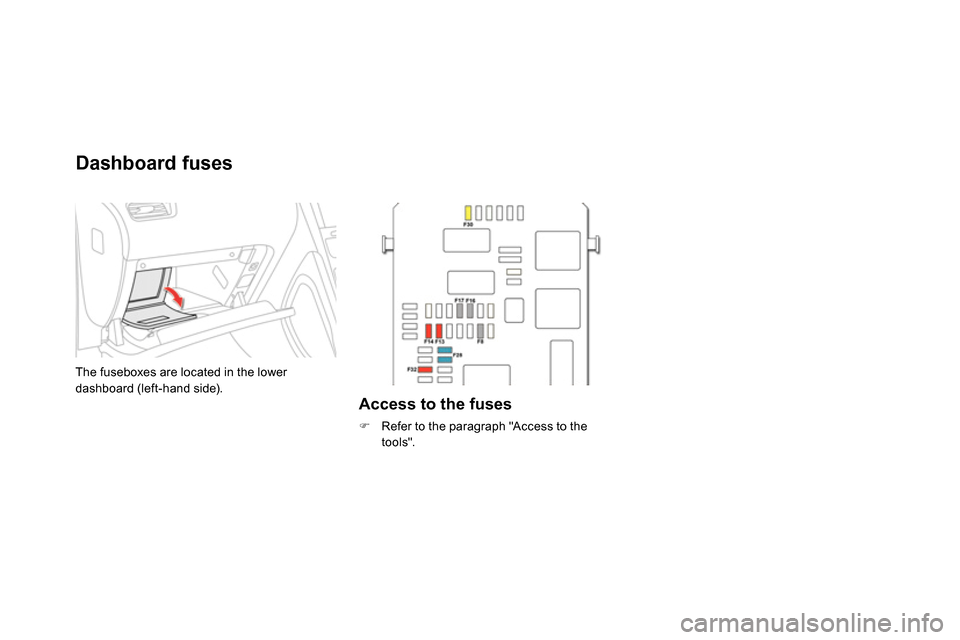
Dashboard fuses
The fuseboxes are located in the lower
dashboard (left-hand side).
Access to the fuses
Refer to the paragraph "Access to the
tools".
Page 273 of 400
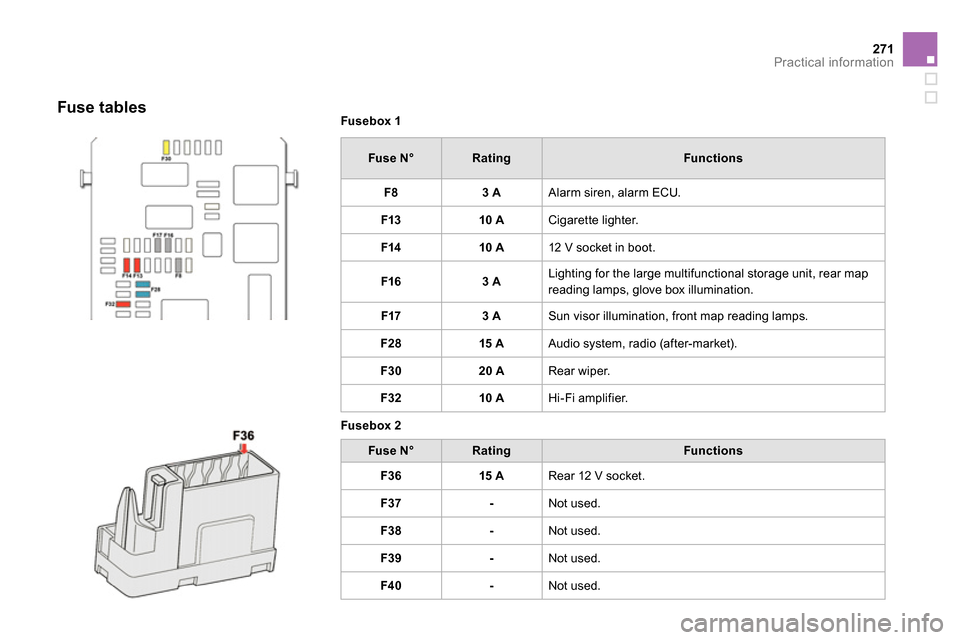
271Practical information
Fusebox 1
Fuse N°
Rating
Functions
F8
3 A
Alarm siren, alarm ECU.
F13
10 A
Cigarette lighter.
F14
10 A
12 V socket in boot.
F16
3 A
Lighting for the large multifunctional storage unit, rear map
reading lamps, glove box illumination.
F17
3 A
Sun visor illumination, front map reading lamps.
F28
15 A
Audio system, radio (after-market).
F30
20 A
Rear wiper.
F32
10 A
Hi-Fi amplifier.
Fusebox 2
Fuse N°
Rating
Functions
F36
15 A
Rear 12 V socket.
F37
-
Not used.
F38
-
Not used.
F39
-
Not used.
F40
-
Not used.
Fuse tables
Page 274 of 400
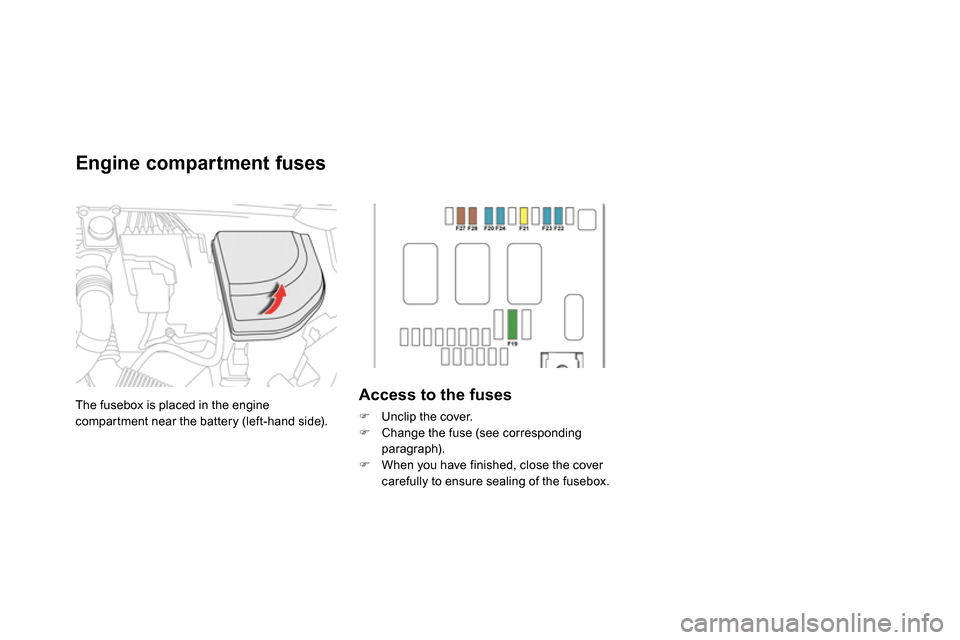
The fusebox is placed in the engine
compartment near the battery (left-hand side).
Access to the fuses
Unclip the cover.
Change the fuse (see corresponding
paragraph).
When you have finished, close the cover
carefully to ensure sealing of the fusebox.
Engine compartment fuses
Page 275 of 400
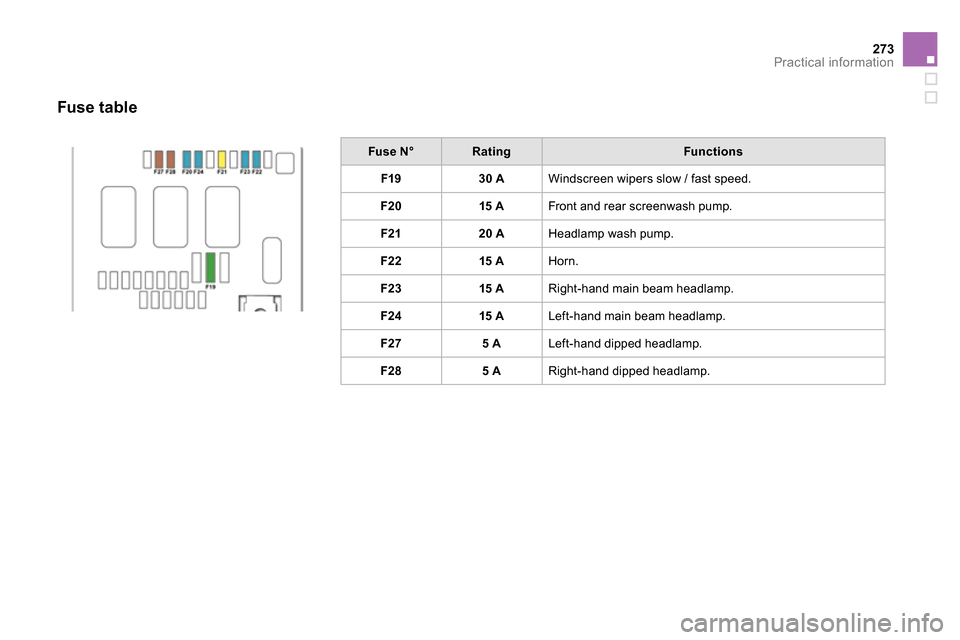
273Practical information
Fuse N°
Rating
Functions
F19
30 A
Windscreen wipers slow / fast speed.
F20
15 A
Front and rear screenwash pump.
F21
20 A
Headlamp wash pump.
F22
15 A
Horn.
F23
15 A
Right-hand main beam headlamp.
F24
15 A
Left-hand main beam headlamp.
F27
5 A
Left-hand dipped headlamp.
F28
5 A
Right-hand dipped headlamp.
Fuse table
Page 276 of 400
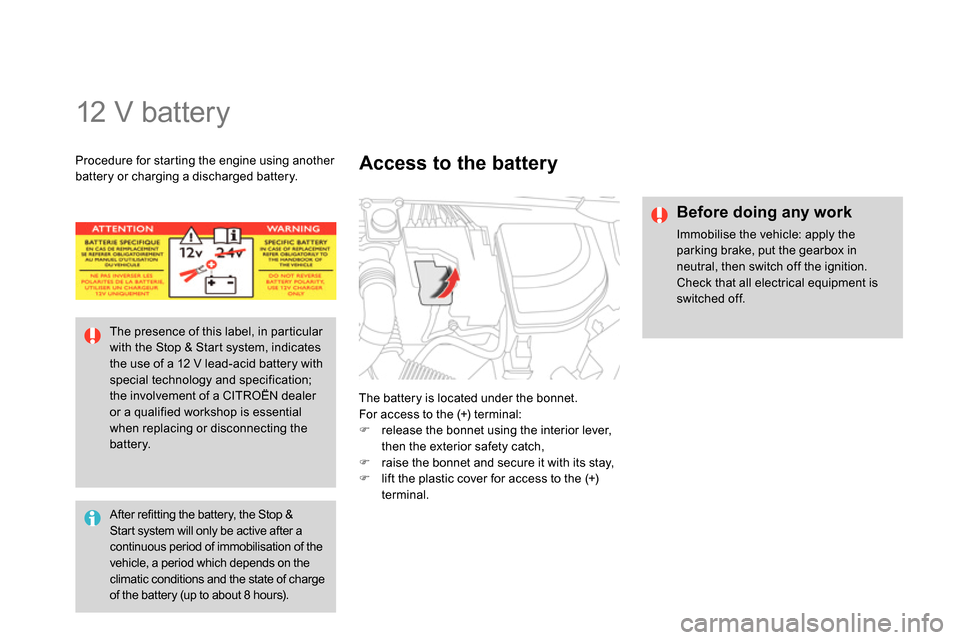
12 V battery
The battery is located under the bonnet.
For access to the (+) terminal:
release the bonnet using the interior lever,
then the exterior safety catch,
raise the bonnet and secure it with its stay,
lift the plastic cover for access to the (+)
terminal.
Access to the battery
After refitting the battery, the Stop &
Start system will only be active after a
continuous period of immobilisation of the
vehicle, a period which depends on the
climatic conditions and the state of charge
of the battery (up to about 8 hours).
The presence of this label, in particular
with the Stop & Start system, indicates
the use of a 12 V lead-acid battery with
special technology and specification;
the involvement of a CITROËN dealer
or a qualified workshop is essential
when replacing or disconnecting the
battery.
Before doing any work
Immobilise the vehicle: apply the
parking brake, put the gearbox in
neutral, then switch off the ignition.
Check that all electrical equipment is
switched off.
Procedure for starting the engine using another
battery or charging a discharged battery.
Page 277 of 400
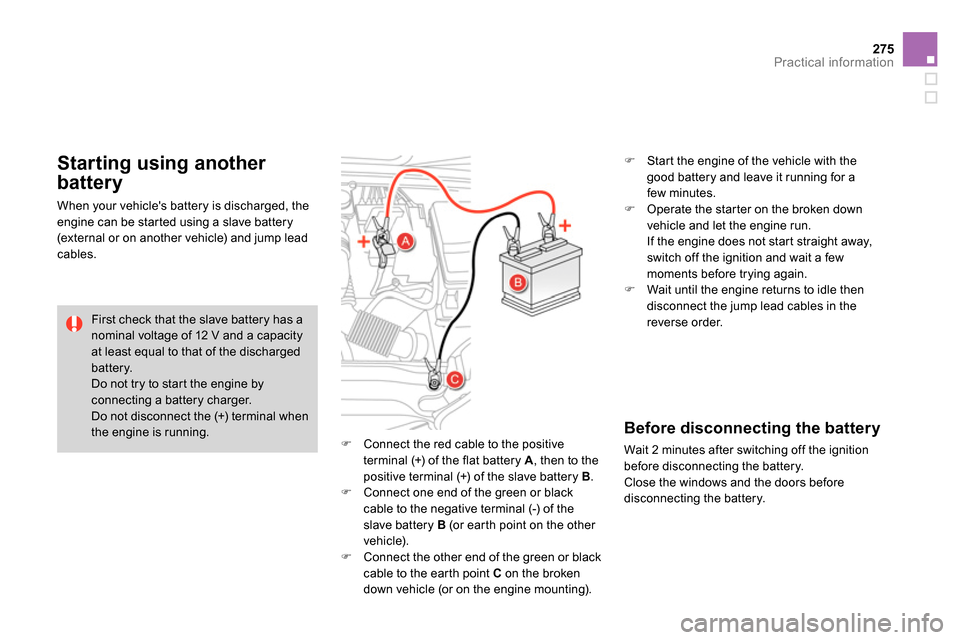
275Practical information
Connect the red cable to the positive
terminal (+) of the flat battery A
, then to the
positive terminal (+) of the slave battery B
.
Connect one end of the green or black
cable to the negative terminal (-) of the
slave battery B
(or earth point on the other
vehicle).
Connect the other end of the green or black
cable to the earth point C
on the broken
down vehicle (or on the engine mounting).
Start the engine of the vehicle with the
good battery and leave it running for a
few minutes.
Operate the starter on the broken down
vehicle and let the engine run
.
If the engine does not star t straight away,
switch off the ignition and wait a few
moments before trying again.
Wait until the engine returns to idle then
disconnect the jump lead cables in the
reverse order.
Starting using another
battery
When your vehicle's battery is discharged, the
engine can be started using a slave battery
(external or on another vehicle) and jump lead
cables.
First check that the slave battery has a
nominal voltage of 12 V and a capacity
at least equal to that of the discharged
battery.
Do not try to start the engine by
connecting a battery charger.
Do not disconnect the (+) terminal when
the engine is running.
Before disconnecting the battery
Wait 2 minutes after switching off the ignition
before disconnecting the battery.
Close the windows and the doors before
disconnecting the battery.
Page 278 of 400
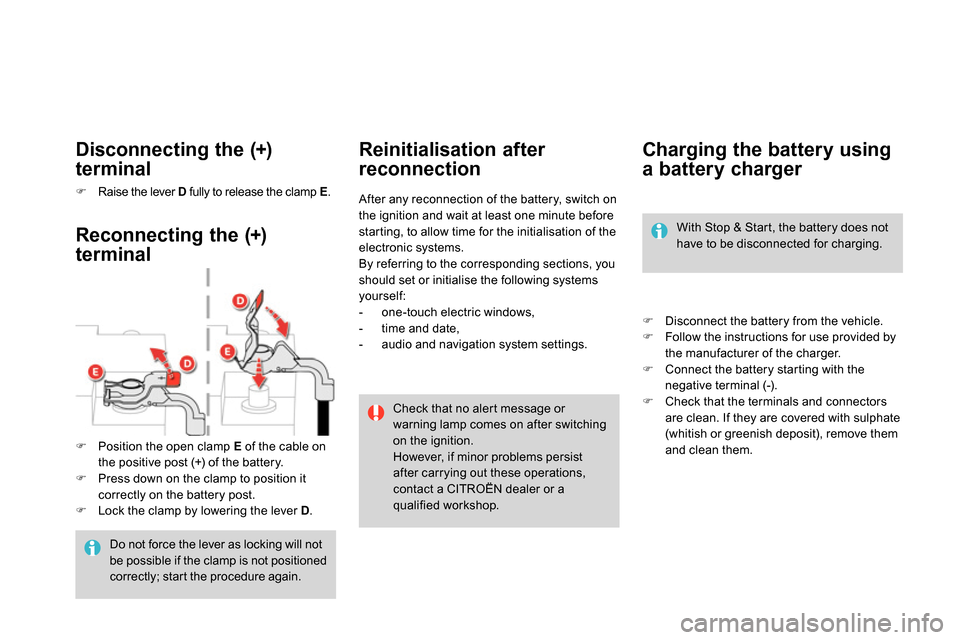
Charging the battery using
a battery charger
Disconnect the battery from the vehicle.
Follow the instructions for use provided by
the manufacturer of the charger.
Connect the battery starting with the
negative terminal (-).
Check that the terminals and connectors
are clean. If they are covered with sulphate
(whitish or greenish deposit), remove them
and clean them.
With Stop & Start, the battery does not
have to be disconnected for charging.
Reinitialisation after
reconnection
After any reconnection of the battery, switch on
the ignition and wait at least one minute before
starting, to allow time for the initialisation of the
electronic systems.
By referring to the corresponding sections, you
should set or initialise the following systems
yourself:
- one-touch electric windows,
- time and date,
- audio and navigation system settings.
Check that no alert message or
warning lamp comes on after switching
on the ignition.
However, if minor problems persist
after carrying out these operations,
contact a CITROËN dealer or a
qualified workshop.
Position the open clamp E
of the cable on
the positive post (+) of the battery.
Press down on the clamp to position it
correctly on the battery post.
Lock the clamp by lowering the lever D
.
Reconnecting the (+)
terminal
Disconnecting the (+)
terminal
Raise the lever D
fully to release the clamp E
.
Do not force the lever as locking will not
be possible if the clamp is not positioned
correctly; start the procedure again.
Page 279 of 400
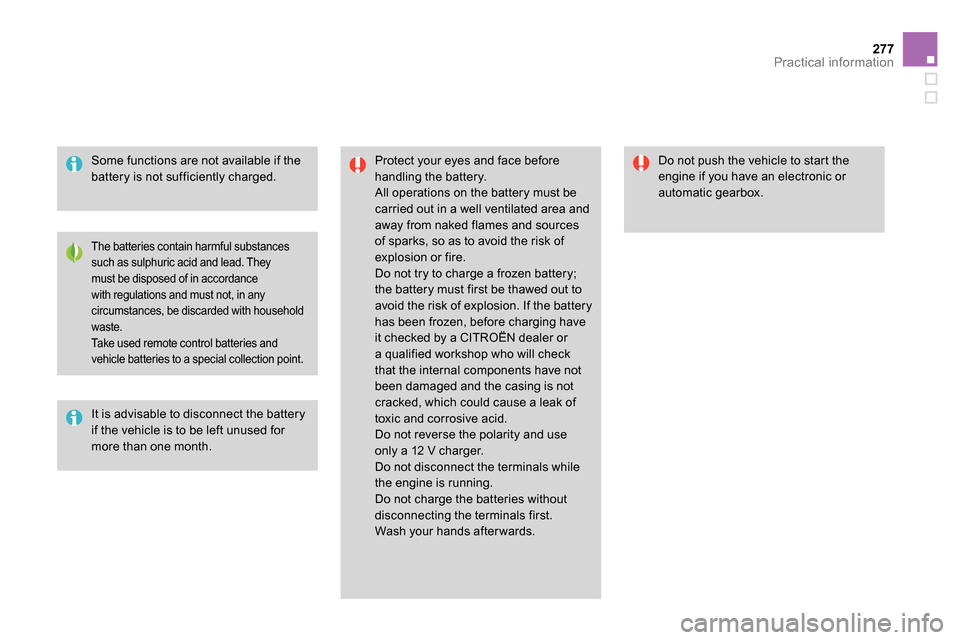
277Practical information
Some functions are not available if the
battery is not sufficiently charged.
Protect your eyes and face before
handling the battery.
All operations on the battery must be
carried out in a well ventilated area and
away from naked flames and sources
of sparks, so as to avoid the risk of
explosion or fire.
Do not try to charge a frozen battery;
the battery must first be thawed out to
avoid the risk of explosion. If the battery
has been frozen, before charging have
it checked by a CITROËN dealer or
a qualified workshop who will check
that the internal components have not
been damaged and the casing is not
cracked, which could cause a leak of
toxic and corrosive acid.
Do not reverse the polarity and use
only a 12 V charger.
Do not disconnect the terminals while
the engine is running.
Do not charge the batteries without
disconnecting the terminals first.
Wash your hands after wards.
It is advisable to disconnect the battery
if the vehicle is to be left unused for
more than one month.
The batteries contain harmful substances
such as sulphuric acid and lead. They
must be disposed of in accordance
with regulations and must not, in any
circumstances, be discarded with household
waste.
Take used remote control batteries and
vehicle batteries to a special collection point.
Do not push the vehicle to start the
engine if you have an electronic or
automatic gearbox.
Page 280 of 400
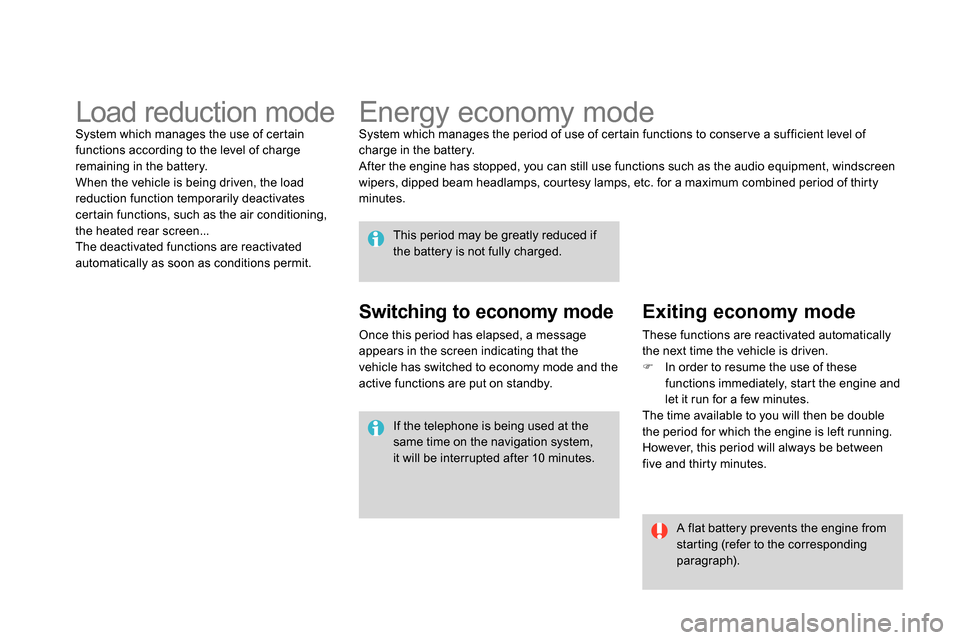
Energy economy mode
System which manages the period of use of certain functions to conser ve a sufficient level of
charge in the battery.
After the engine has stopped, you can still use functions such as the audio equipment, windscreen
wipers, dipped beam headlamps, courtesy lamps, etc. for a maximum combined period of thirty
minutes.
This period may be greatly reduced if
the battery is not fully charged.
A flat battery prevents the engine from
starting (refer to the corresponding
paragraph). If the telephone is being used at the
same time on the navigation system,
it will be interrupted after 10 minutes.
Switching to economy mode
Once this period has elapsed, a message
appears in the screen indicating that the
vehicle has switched to economy mode and the
active functions are put on standby.
Exiting economy mode
These functions are reactivated automatically
the next time the vehicle is driven.
In order to resume the use of these
functions immediately, start the engine and
let it run for a few minutes.
The time available to you will then be double
the period for which the engine is left running.
However, this period will always be between
five and thirty minutes.
Load reduction mode
System which manages the use of certain
functions according to the level of charge
remaining in the battery.
When the vehicle is being driven, the load
reduction function temporarily deactivates
certain functions, such as the air conditioning,
the heated rear screen...
The deactivated functions are reactivated
automatically as soon as conditions permit.